Abstract
Egyptian policymakers and researchers have been working to address the challenge of bridging the gap between limited water resources and the growing population’s needs for agricultural and food production. The National Great Project for Lining and Rehabilitation of All Open Canals of the Irrigation Network aims to reduce irrigation water losses through seepage, evaporation, and evapotranspiration. This study evaluated water losses from the Al Maanna canal network in the Assiut governorate, Middle Egypt, using empirical formulas and field ponding methods. The results show the Moleth–Worth formula was more compatible with field measurements, with estimated seepage losses of 2.07 and 2.20 million m3/month, respectively. Moreover, maximum evaporation and evapotranspiration losses were 0.086 and 1.133 million m3/month, respectively. Consequently, total water losses from the Al Maanna canal are estimated to be 3.42 million m3/month, accounting for 13.63% of the total discharge. After canal rehabilitation, evaporation and evapotranspiration losses significantly decreased, while seepage losses were lowered to 0.472 million m3/month, as estimated using the field ponding method. Hence, lining the Al Maanna canal network could reduce water losses by 84%, promoting lining processes that yield significant benefits such as moral, cultural, and environmental benefits. This approach outweighs implementation expenses and ensures a sustainable water supply.
1. Introduction
Bridging the rapidly rising gap between the small amount of water that is now accessible and the enormous amount necessary to meet the needs of growing populations for agricultural and food production has been one of the main challenges facing Egyptians recently [1]. That is why Egyptian policymakers as well as scientific researchers in Egypt have focused on finding radical solutions to the problem and providing the largest possible amount of water through more than one tool at the same time. In addition to proceeding with extreme degrees of rationalization of water use in all sectors, the National Great Project for Lining and Rehabilitation of All Open Canals of the Irrigation Network all over the Egyptian countryside was recently implemented, mainly to address the main reason for irrigation water losses through seepage in permeable soil [2]. That project not only preserves the seeped quantities of water but also minimizes the quantities that were lost through evaporation and evapotranspiration due to controlling the designed cross sections of all irrigation water streams. Additionally, the project stops the increase in water sections, distortions, and swimming processes, as well as the growth of weeds and plants in irrigation water canals, which will decrease the quantities of water lost.
The Egyptian irrigation authorities expect to save about five thousand million cubic meters of water a year [3]. This is a significant amount of water gained from such a large national project, in addition to other significant benefits expected in the environment, health, and social sectors.
Much of Egypt’s population lives in rural areas with low incomes, lacking basic water supply and sanitation, leading to health, economic, and social inequalities. Inequitable water distribution causes social unrest in rural Egypt [4], with local-scale water-based protests rooted in water management and agriculture development politics.
Earthen irrigation canals experience significant water losses, including through seepage, evaporation, and evapotranspiration, which significantly reduce water supplies. These losses are discussed in detail in the following sections:
1.1. Seepage Losses
Seepage losses from a unit length of 1 km of Egypt’s earthen irrigation canals, which account for a significant portion of canal water losses, are determined by several factors, such as soil permeability, canal water depth, length of wetted perimeter, channel geometry, location of the groundwater table, velocity of flowing water, and so on. Worldwide, several researchers have studied seepage losses from the earthen canals, as shown in Table 1.

Table 1.
Examples of previous studies on measuring of seepage losses from earthen canals.
Previous studies employed two basic strategies to quantify seepage losses from earthen canals: experimental formulas and field methods.
1.1.1. Experimental Formulas for Measuring Seepage Losses
Table 2 introduces a variety of experimental formulas that were used to quantify seepage losses from earthen canals.

Table 2.
Experimental formulas for estimating seepage losses.
1.1.2. The Field Ponding Method for Measuring of Seepage Losses
The field ponding method was used for measuring seepage losses. The method represents a direct method for measuring seepage losses from a considerable length of a canal, based on restricting water in a certain reach of the canal and then measuring the water level twice: once after the restriction process and again after 24 h. The reduction in the water level is considered a seepage loss [10], as shown in Figure 1.
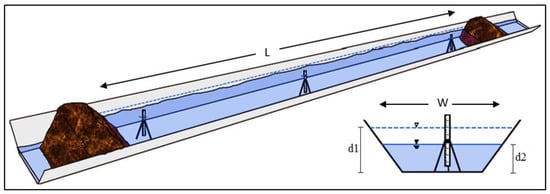
Figure 1.
Ponding method for measuring of seepage losses.
To determine the seepage rates in ponding tests, Leigh [10] presented the equation shown below:
where: SF—average seepage losses from the ponded reach (ft3/ft2/day); W—average width of water surface in the ponded reach (ft); d1—water depth at the beginning of measurement in the ponded reach (ft); d2—water depth in the ponded reach after 24 h (ft); P—average wetted perimeter in the ponded reach (ft); L—length of canal ponded reach (ft).
1.2. Evaporation Losses
Evaporation losses from the open canals, which depend mainly on the surface wind speed, are negligible in comparison to seepage losses. Suhua et al. [13] used two methods to investigate evaporation losses from the middle reaches of the Heihe River in northern China: (i) the aerodynamic method based on the double-deck surface air layer (DSAL) model, and (ii) the heat balance method. The results showed that cumulative evaporation losses estimated by the DSAL model were equal in order of magnitude to those estimated by the heat balance method. The evaporation losses were determined to be less than 1% of the total designed discharge. They also provided the following equation to predict a canal’s evaporation losses:
where: R—Evaporation losses from the open canals (m3/day); Ep—Pan Evaporation (mm/day); Kp—Pan coefficient (0.60); W—Width of water surface in the canal (m); L—Length of canal (m).
1.3. Evapotranspiration Losses
Transpiration from the crops and evaporation from the soil make up the evapotranspiration in a cropped area. The evapotranspiration rate (crop water use) is determined by the crop type, growth stage, soil moisture content, and available energy to evaporate water [14]. The reference crop evapotranspiration (ETo) and an average crop coefficient (Ka) are used to calculate crop water use (ETc) [15], as follows:
The average crop coefficient (Ka) is estimated, as follows [16]:
where: Ka—Average crop coefficient; Kcb—Basal crop coefficient; Kw—Wet soil evaporation; Ks—Water stress factor.
On the other hand, Jensen et al. [17] examined 20 methods to estimate ETo for arid and humid areas. For both areas, they found that the Penman–Monteith technique was the most accurate. The approach introduced by El-Enany et al. [14] is used to calculate the water consumption (evapotranspiration losses) from a cultivated area as follows:
where: WC—Water consumptive needed (m3/s); ETo—Reference crop evapotranspiration (mm/day); Ka—Average crop coefficient; A—Area cultivated (feddan).
As a sample case study for the Middle Egypt region, the current field study intended to assess the water losses from the Al Maanna canal network in the Assiut governorate. The study also aimed to survey literature relationships for accurate seepage estimation. We used equations suitable for the Egyptian soil, climate, and irrigation systems to estimate lost water quantities and to compare seepage water quantities from designed water sections with measured field dimensions. The study also included an economic analysis of the costs saved as a result of the lining process in the selected research area. Lining irrigation canals can significantly reduce water losses, providing moral, cultural, and environmental benefits. This approach outweighs implementation expenses and ensures a sustainable water supply, making the water gained more valuable than implementation costs.
2. Materials and Methods
2.1. Methodology
The following procedures will be utilized to assess water losses from distorted irrigation networks in Assiut governorate as well as the positive effects of the rehabilitation process: (i) choosing and describing a study area; (ii) surveying the different soil types in the study area; (iii) collecting meteorological data that affects evaporation and evapotranspiration losses; (iv) collecting field data that affects seepage, evaporation, and evapotranspiration losses; (v) analyzing and discussing seepage, evaporation, and evapotranspiration losses (before and after rehabilitation).
2.2. Study Area
One of the major canals in the Assiut governorate is the Al Maanna Canal. It irrigates a cultivated area of around 13,500 feddan and takes its water from the Eastern Naga Hammady Canal. The Al Maanna Canal is around 32.8 km long. As illustrated in Figure 2, this length is divided into five reaches where the less regulated canals branch on both sides. The length of the branches as a whole is about 47 km [18]. The characteristics of the Al Maanna Canal and its branches are documented in Table 3.
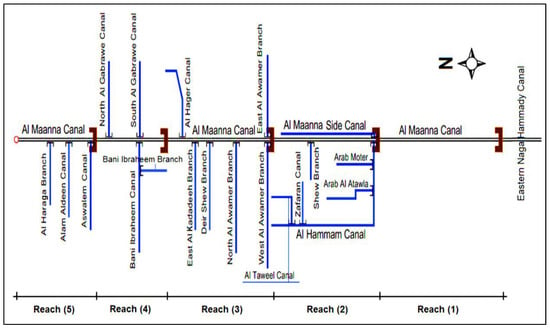
Figure 2.
Schematic diagram of Al Maanna canal and its branches.

Table 3.
Characteristics of Al Maanna Canal and its branches [18].
2.3. Soil Types
It was necessary to collect several soil samples along the canals’ pathways in order to identify the kind of soil, degree of permeability, and other physical properties. Soil samples were taken from various depths beneath the canal bed and from the side slopes every 5 km along the main canal, and one sample was taken for each off-taking canal. As reported in Table 4, all of these samples were subjected to sieve analysis, a liquid limit, a plastic limit, a plasticity index test, and a group index test in order to estimate all of these parameters and coefficients. As well as analyzing the soil samples that were collected from the field, soil classification analysis was verified using remote sensing and GIS techniques. Mapping was performed using ArcGIS 9.2 software (Appendix A). The study area primarily had a clay loam upper texture up to 30 cm, with clay (light) subsoil and inclusions.

Table 4.
The used soil coefficients in the empirical equations.
2.4. Meteorological Data
Using data from the Arab Al-Awamer Weather Station [19], Table 5 displays the monthly meteorological information currently available for the understudied area. These data include air temperature (T), relative humidity (RH), pan evaporation (Ep), wind speed, and number of sunny hours per day (SH/day). In order to calculate the evaporation and evapotranspiration losses from the Al Maanna canal and its branches, meteorological data were used, as evaluated and explained below.

Table 5.
Meteorological data of the study area [19].
2.5. Field Data
The gathered data from the study area of the Al Maanna canal and its branches were based on the required parameters to measure seepage, evaporation, and evapotranspiration losses from the network, as indicated below.
2.5.1. Field Parameters of Seepage Losses
Using the field ponding method, displayed in Figure 3, water was restricted for significant lengths of the Al Maanna canal and its branches in order to measure seepage losses. The water level was then measured twice, once immediately following the restriction procedure and once again after 24 h, using the measuring tool shown in Figure 4. The seepage rates for the ponding test were computed using Leigh’s Equation (1) [10].
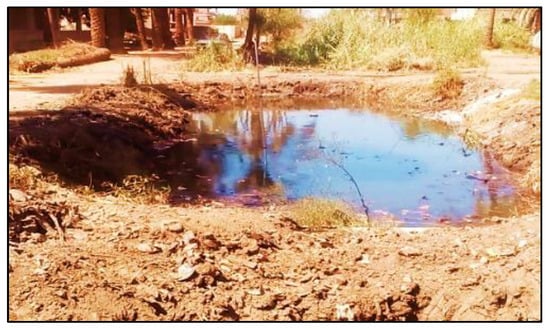
Figure 3.
Ponding method for measuring of seepage losses.
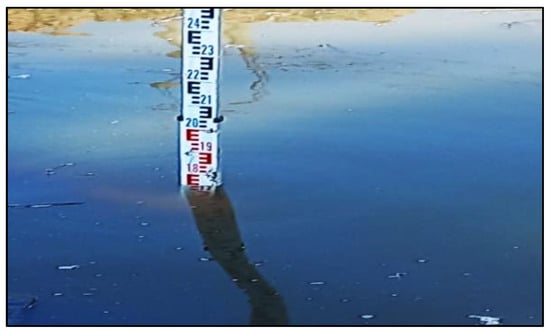
Figure 4.
Measuring device of ponding method.
2.5.2. Field Parameters of Evaporation Losses
Depending on the top width of the exposed water surface, evaporation losses occur from both the designed (rehabilitated) and distorted cross sections of canals. According to Figure 5, the evaporation rate from the canal’s distorted cross section will be positive (higher than the evaporation rate from the designed cross section), if the top water surface in the distorted cross section is greater than the top water surface in the designed cross section. However, as illustrated in Figure 6, if the top water surface in the distorted cross section is lower than the top water surface in the designed (rehabilitated) cross section, the canal’s evaporation rate will be negative (less than the evaporation rate from the designed cross section). Every 200 m along the canal’s length, the distorted cross sections of the Al Maanna canal and its branches were measured and compared to the designed cross sections. Using the meteorological data in Table 5 and Equation (2) from Suhua et al. [13], the evaporation rates from the designed and distorted cross sections were calculated.
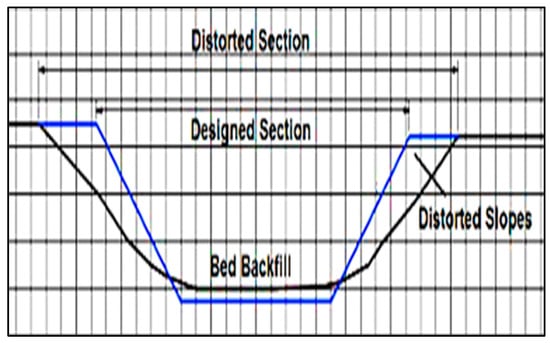
Figure 5.
An example of positive evaporation rate.
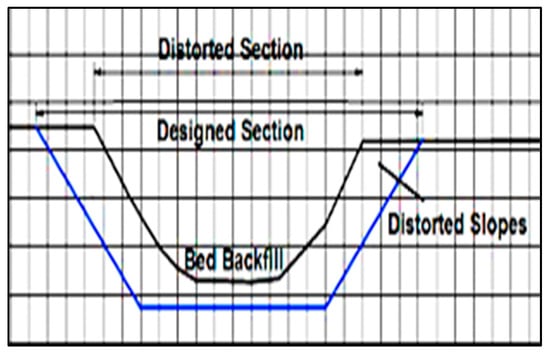
Figure 6.
An example of negative evaporation rate.
2.5.3. Field Parameters of Evapotranspiration Losses
Aquatic weeds are undesirable plants that play a vital role in various ecosystems, and many of them inflict massive direct and indirect losses. Many irrigation canals are suffering from significant weed growth along the canal sides as well as siltation along the canal bed. This has an effect on hydraulic characteristics such as increased roughness, which affects flowing velocity, and decreased cross section, which limits the flow capacity of irrigation canals and hence the availability of water to farmers. Weeds that are growing along the Al Maanna canal’s banks and its branches, shown in Figure 7, are a source of evapotranspiration losses from the network. Using a field measuring wheel, shown in Figure 8, the dimensions of the weeds were determined. These measurements were used to calculate the weed growth areas along the Al Maanna Canal and its branches, as shown in Table 6.
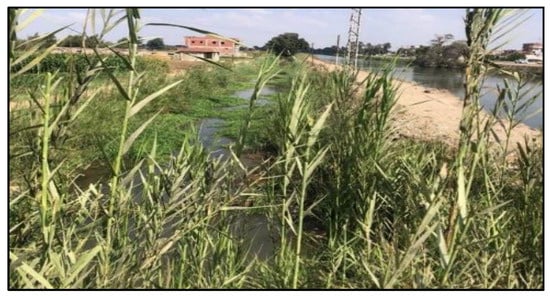
Figure 7.
Example of weeds along Al Maanna canal network.
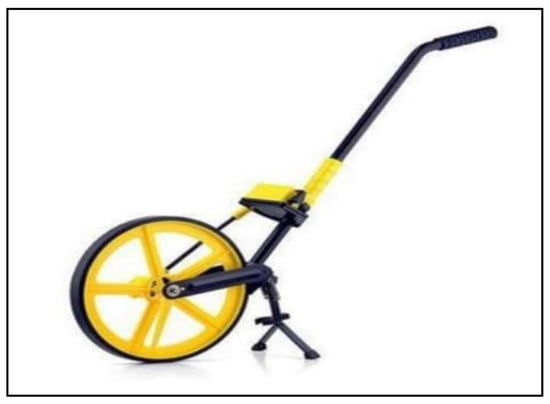
Figure 8.
Measuring wheel used to measure weeds along canals.

Table 6.
Measured areas of weeds along Al Maanna canal and its branches.
On the basis of the meteorological information presented in Table 5 and the CROP-WATER software model, which was used to calculate the reference evapotranspiration (ETo) from the weeds, the evapotranspiration losses from the weeds along the Al Maanna canal and its branches were calculated using Equation (5) developed by El-Enany et al. [14]. It is worth noting that the CROPWATER software is based on the Penman–Monteith method [20].
3. Results and Discussion
Using a literature search and the information gathered for the study region, it was possible to calculate the seepage, evaporation, and evapotranspiration losses from the distorted and designed (rehabilitated) cross sections of the Al Maanna canal and its branches in the Assiut governorate. Each type of water loss from the network was determined by a separate analysis of the parts listed below.
3.1. Seepage Losses
In addition to the experimental formulas mentioned in Table 2, the seepage losses from the distorted cross sections of the Al Maanna canal and its branches were calculated using the field ponding method, as shown in Figure 9 and Figure 10.
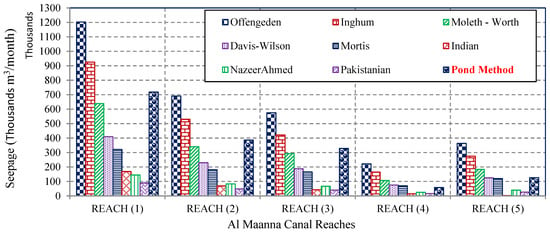
Figure 9.
Seepage losses from the distorted sections of Al Maanna canal.
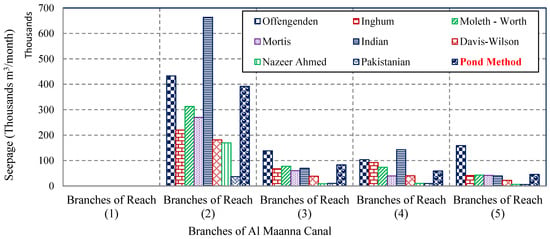
Figure 10.
Seepage losses from the distorted sections of branches of Al Maanna canal.
According to the Offengenden experimental formula, it can be seen from Figure 9 that the Al Maanna canal’s largest seepage losses occurred in the first reach. The fourth reach exhibited the lowest seepage losses, according to the experimental Indian formula.
According to Figure 10, the largest seepage losses from the Al Maanna canal branches came from the branches of the second reach, measured by the Indian experimental formula. In contrast, according to a Pakistani experimental formula, branches of the last reach caused the fewest seepage losses. It should be noted that there is no branching in the Al Maanna Canal’s first reach; also, the third reach contains six canals totaling 5.54 m3/s of discharge and 9.07 km of impermeable, silty, loamy soil. The fourth reach includes four canals with a combined length of 6.3 km and a discharge rate of 6.01 m3/s. These canals are more permeable than the third reach because the soil there is silty with sand. This explains why the seepage loss values between the third and fourth reaches are convergent, despite the third reach’s increased canal number.
As shown in Figure 9 and Figure 10, the field ponding method and the experimental Moleth–Worth and Yennidunia methods were compatible for calculating seepage losses. The distorted cross sections of the Al Maanna canal had seepage losses of 1.563 and 1.617 million m3/month, respectively. The Moleth–Worth formula and field ponding method estimated seepage losses from branches of the Al Maanna canal to be 0.506 and 0.580 million m3/month, respectively.
The field ponding method was used to calculate seepage losses from the lined cross sections following the lining and rehabilitation of the Al Maanna canal and its branches, as shown in Figure 11 and Figure 12.
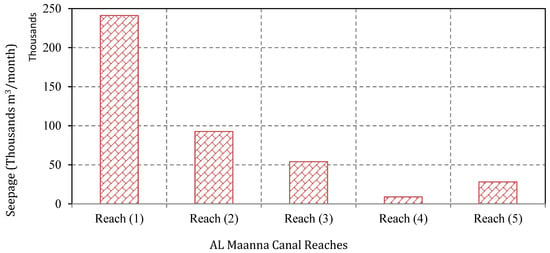
Figure 11.
Seepage losses from the rehabilitated sections of Al Maanna canal.
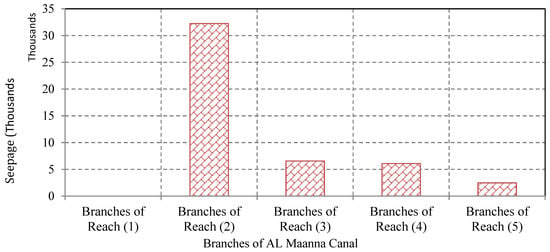
Figure 12.
Seepage losses from the rehabilitated sections of branches of Al Maanna canal.
As shown in Figure 11, the first reach of the Al Maanna Canal had the greatest seepage losses from the rehabilitation sections. The least amount of seepage loss occurred in the fourth-lined reach. In addition, Figure 12 demonstrates that lined branches in the second reach of the Al Maanna canal produced the largest seepage losses, while the lined branches in the final reach contributed to the least amount of seepage losses.
There is a noticeable discrepancy between the calculated seepage losses from the distorted cross sections and the rehabilitated sections. The large amounts of seepage losses in the Al Maanna canal network were greatly decreased after the lining and rehabilitation procedure, to roughly 0.472 million m3/month, or nearly 21.48% of seepage losses before rehabilitation.
3.2. Evaporation Losses
As observed in Figure 13 and Figure 14, there is a notable difference in the evaporation losses from Al Maanna Canal and its branches acquired from the distorted (earthen) and lined (designed) sections. Due to the narrower top width of the exposed water surface in the rehabilitated sections, evaporation losses from the lined (designed) sections were smaller than those from the distorted (earthen) sections.
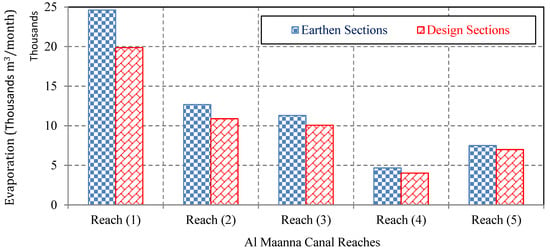
Figure 13.
Evaporation losses from distorted and lined sections of Al Maanna Canal.
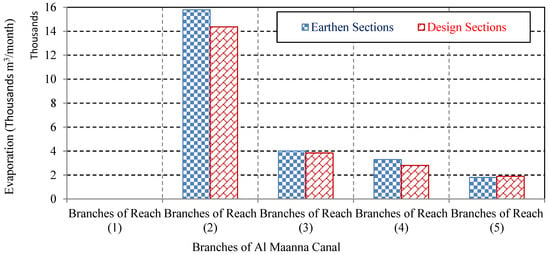
Figure 14.
Evaporation losses from distorted and lined branches of Al Maanna canal.
It should also be noted that branches of the last reach exhibited negative evaporation losses, as illustrated in Figure 14, which is regarded as a sign of decreased distorted cross sections compared to lined sections in these branches. Around 60,789 and 24,899 m3/month of evaporation losses from the Al Maanna canal’s distorted sections and its branches, respectively, were calculated. On the other hand, the evaporation losses from the lined sections of the Al Maanna Canal and its branches were calculated to be roughly 51,856 and 22,905 m3/month, respectively. As a result, the rehabilitation of the Al Maanna canal network could minimize evaporation losses by about 10,926 m3/month.
3.3. Evapotranspiration Losses
With a rate of about 235,630 m3/month, the first reach of the Al Maanna canal had the highest evapotranspiration rate from weeds. The minimum evapotranspiration rate from weeds occurred in the fourth reach, at around 73,634 m3/month, as shown in Figure 15.
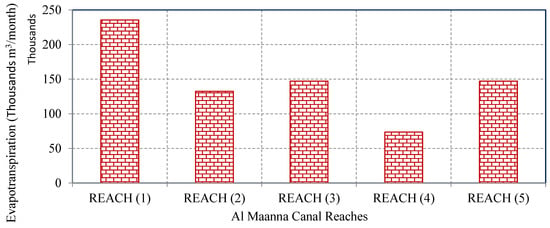
Figure 15.
Evapotranspiration losses from weeds along Al Maanna canal.
On the other hand, Figure 16 shows that both the maximum and minimum evapotranspiration rates from weeds were approximately 242,025 m3/month from the branches of the second reach and approximately 41,647 m3/month from the branches of the fourth reach. Accordingly, the overall evapotranspiration losses might be 1,133,234 m3/month, or almost 4.50% of the Al Maanna canal’s discharge. This demonstrates the huge quantity of weeds that grow on both sides of the Al Maanna canal network.
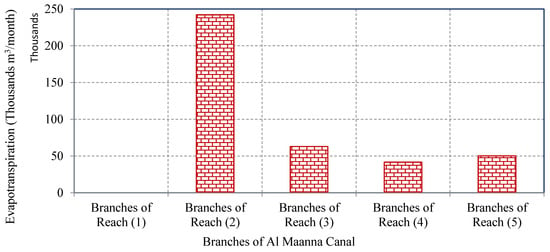
Figure 16.
Evapotranspiration losses from weeds along branches of Al Maanna canal.
3.4. An Economic Study of the Lining Process in the Study Area
The two main problems with traditional irrigation networks are (i) the growth of weeds along canal banks and (ii) bed backfill. Every three months, weeds are pulled, and once a year, beds are dug up for canal dredging. According to MWRI [21], bed dredging for canals with a designed bed width of 10 m costs about EGP 8/m3, while weed removal costs about EGP 5000 per kilometer (EGP/km). Table 7 and Table 8 show the overall costs of bed dredging and weed removal from the distorted cross sections of Al Maanna canal and its branches.

Table 7.
Costs of bed dredging and weed removal from Al Maanna canal cross sections.

Table 8.
Costs of bed dredging and weeds’ removal from branches of Al Maanna canal.
Since weed removal from Al Maanna Canal and its branches needs to be performed every three months, the annual cost of doing so is almost EGP 1.498 million.
According to the results of the preceding tables, the costs of bed dredging from the Al Maanna canal and its branches are roughly EGP 5,304,030 and EGP 533,363, respectively. Each year, it costs between EGP 573,393 and EGP 925,380 to remove weeds from Al Maanna Canal and its branches. After the lining and rehabilitation processes, these expenses can be avoided.
4. Conclusions
The following major conclusions may be drawn after analyzing the seepage, evaporation, and evapotranspiration losses from the distorted and lined sections of the Al Maanna canal and its branches:
- The results obtained using the most widely used equations for predicting the estimated values of seeping water from the Al Maanna Canal were notably different. This is due to the varying conditions and properties of the soil in which the experiments were conducted, which resulted in each equation.
- The results obtained using the Moleth–Worth formula were most consistent with the measured seeping quantities of water using the field ponding method. The measured seeping quantities from the Al Maanna canal were around 1.563 million m3/month, while the calculated quantities using the Moleth–Worth equation were 1.617 million m3/month. Additionally, the approximate seepage losses from the Al Manna canal branches were 0.506 and 0.580 million m3/month, respectively, indicating a tolerable approximation difference.
- The maximum calculated evaporation and evapotranspiration losses from the Al Maanna canal were roughly 0.061 and 0.736 million m3/month, respectively, while the maximum evaporation and evapotranspiration losses from the Al Maanna canal branches were calculated to be approximately 0.0249 and 0.397 million m3/month, respectively.
- The overall seepage, evaporation, and evapotranspiration losses from the Al Maanna canal network are estimated to be around 3.42 million m3/month, accounting for approximately 13.63% of the Al Maanna canal’s total discharge.
- Following the lining process, the field ponding method was used to estimate seepage losses from the Al Maanna canal and its branches, which were approximately 0.472 million m3/month. Additionally, evaporation losses can be decreased to roughly 0.075 million m3/month after the rehabilitation procedure, while evapotranspiration losses are ignored.
- The lining of distorted sections of the Al Maanna canal and its branches can reduce water losses by approximately 84%, which is good and sufficient to recommend and encourage lining processes where the gained quantities of water will be more valuable and important than the cost of implementation.
- Estimated savings would be no less than EGP 5.84 million per year and EGP 1.50 million per year on the costs of periodic maintenance and removal of weeds for Al Maanna canal’s sections and branches.
Author Contributions
Conceptualization, M.S.A.N. and T.S.A.-Z.; methodology, M.S.A.N. and T.S.A.-Z.; software, T.S.A.-Z.; formal analysis, M.S.A.N. and T.S.A.-Z.; investigation, M.S.A.N.; resources M.S.A.N.; data curation, M.A.A. and T.S.A.-Z.; writing—original draft preparation, M.S.A.N.; writing—review and editing, T.S.A.-Z.; visualization, M.A.A.; supervision, M.A.A. and T.S.A.-Z.; project administration, M.A.A. All authors have read and agreed to the published version of the manuscript.
Funding
This research received no external funding.
Data Availability Statement
The underlying research data used in this work were obtained officially from the Egyptian Ministry of Irrigation and Water Resources, while other used data were extracted from the results of previous studies in the field’s scientific research literature.
Acknowledgments
The authors would like to mention that the second author involved in this paper has passed away before finishing it; the rest of the authors completed the paper and published it as a gift to his soul, praying for mercy and forgiveness for him.
Conflicts of Interest
The authors declare no conflict of interest.
Appendix A
There were different parameters and coefficients used in the empirical equations pertaining to the study according to each. They were determined by identifying the soil types after the soil samples were classified following sieve analysis according to the American Association of State Highway and Transportation Officials (AASHTO).
In addition to analyzing the soil samples collected from the field, our soil classification analysis was verified using remote sensing and GIS techniques. Mapping was performed using ArcGIS 9.2 software. In the study area, the majority of the upper soil texture was clay loam up to 30 cm while the subsoil, the associated soil, and inclusions were clay (light), Figure A1. The map was extracted using remote sensing and GIS techniques and the Harmonized World Soil Database (HWSD) compiled by the FAO organization.

Figure A1.
GIS map of Al Maanna canal and its branch network.

Table A1.
The soil mapping data were extracted using remote sensing and GIS techniques and the Harmonized World Soil Database (HWSD) compiled by the FAO organization.
Table A1.
The soil mapping data were extracted using remote sensing and GIS techniques and the Harmonized World Soil Database (HWSD) compiled by the FAO organization.
| Dominant Soil Group | Associated Soil and Inclusions | ||
|---|---|---|---|
| Coverage | SOTWIS | ||
| Soil Mapping Unit | 16,413 | ||
| FL—Fluvisols | |||
| Sequence | 1 | 2 | 3 |
| Share in Soil Mapping Unit (%) | 50 | 25 | 25 |
| Database ID | 16,219 | 16,220 | 16,221 |
| Soil Unit Symbol (FAO 74) | - | - | - |
| Soil Unit Name (FAO74) | - | - | - |
| Soil Unit Symbol (FAO 85) | - | - | - |
| Soil Unit Name (FAO 85) | - | - | - |
| Soil Unit Symbol (FAO 90) | FLc | GLe | VRe |
| Soil unit Name (FAO 90) | Calcaric Fluvisols | Eutric Gleysols | Eutric Vertisols |
| Topsoil Texture | Medium | Medium | Fine |
| Reference Soil Depth (cm) | 100 | 100 | 100 |
| PHASE1 | - | - | - |
| PHASE2 | - | - | - |
| Obstacles to Roots (ESDB) (cm) | - | - | - |
| Impermeable Layer (ESDB) (cm) | - | - | - |
| Soil Water Regime (ESDB) | - | - | - |
| Drainage Class (0–0.5% slope) | Moderately Well | Poor | Poor |
| AWC (mm) | 150 | 150 | 125 |
| Gelic Properties | No | No | No |
| Vertic Properties | No | No | Yes |
| Petric Properties | No | No | No |
| Topsoil Sand Fraction (%) | 41 | 40 | 21 |
| Topsoil Silt Fraction (%) | 39 | 31 | 25 |
| Topsoil Clay Fraction (%) | 20 | 29 | 54 |
| Topsoil USDA Texture Classification | Loam | Clay Loam | Clay (Light) |
| Topsoil Reference Bulk Density (kg/dm3) | 1.4 | 1.35 | 1.22 |
| Topsoil Bulk Density (kg/dm3) | 1.43 | 1.34 | 1.51 |
| Topsoil Gravel Content (%) | 1 | 1 | 1 |
| Topsoil Organic Carbon (% Weight) | 0.47 | 0.93 | 1.07 |
| Topsoil pH (H2O) | 8 | 6.1 | 6.9 |
| Topsoil CEC (clay) (cmol/kg) | 56 | 34 | 68 |
| Topsoil CEC (soil) (cmol/kg) | 13 | 13 | 40 |
| Topsoil Base Saturation (%) | 100 | 81 | 100 |
| Topsoil TEB (cmol/kg) | 13 | 10.5 | 40 |
| Topsoil Calcium Carbonate (% Weight) | 10.9 | 0 | 0.4 |
| Topsoil Gypsum (% weight) | 0.2 | 0 | 0.1 |
| Topsoil Sodicity (ESP) (%) | 3 | 2 | 1 |
| Topsoil Salinity (ECe) (dS/m) | 0.6 | 0 | 0.3 |
| Database ID | 16,219 | 16,220 | 16,221 |
| Subsoil Sand Fraction (%) | 42 | 37 | 20 |
| Subsoil Silt Fraction (%) | 38 | 28 | 24 |
| Subsoil Clay Fraction (%) | 20 | 35 | 56 |
| Subsoil USDA Texture Classification | Loam | Clay Loam | Clay (Light) |
| Subsoil Reference Bulk Density (kg/dm3) | 1.41 | 1.31 | 1.21 |
| Subsoil Bulk Density (kg/dm3) | 1.46 | 1.43 | 1.58 |
| Subsoil Gravel Content (%) | 1 | 1 | 1 |
| Subsoil Organic Carbon (% weight) | 0.34 | 0.33 | 0.56 |
| Subsoil pH (H2O) | 8.1 | 6.4 | 7.5 |
| Subsoil CEC (clay) (cmol/kg) | 60 | 38 | 70 |
| Subsoil CEC (soil) (cmol/kg) | 13 | 14 | 41 |
| Subsoil Base Saturation (%) | 100 | 86 | 100 |
| Subsoil TEB (cmol/kg) | 13 | 12 | 41 |
| Subsoil Calcium Carbonate (% weight) | 11.2 | 0.1 | 1.4 |
| Subsoil Gypsum (% weight) | 0.4 | 0 | 0.1 |
| Subsoil Sodicity (ESP) (%) | 3 | 2 | 2 |
| Subsoil Salinity (ECe) (dS/m) | 0.4 | 0 | 0.3 |
| Dominant Soil Group | Associated Soil and Inclusions | ||
| Coverage | SOTWIS | ||
| Soil Mapping Unit | 16,468 | ||
| Dominant Soil Group | LP—Leptosols | ||
| Sequence | 1 | 2 | 3 |
| Share in Soil Mapping Unit (%) | 60 | 30 | 10 |
| Database ID | 16,347 | 16,348 | 16,349 |
| Soil Unit Symbol (FAO 74) | - | - | - |
| Soil Unit Name (FAO74) | - | - | - |
| Soil Unit Symbol (FAO 85) | - | - | - |
| Soil Unit Name (FAO 85) | - | - | - |
| Soil Unit Symbol (FAO 90) | LPe | LPq | FLc |
| Soil unit Name (FAO 90) | Eutric Leptosols | Lithic Leptosols | Calcaric Fluvisols |
| Topsoil Texture | Medium | Medium | Medium |
| Reference Soil Depth (cm) | 30 | 10 | 100 |
| PHASE1 | - | - | - |
| PHASE2 | - | - | - |
| Obstacles to Roots (ESDB) (cm) | - | - | - |
| Impermeable Layer (ESDB) (cm) | - | - | - |
| Soil Water Regime (ESDB) | - | - | - |
| Drainage class (0–0.5% slope) | Imperfectly | Imperfectly | Moderately Well |
| AWC (mm) | 50 | 15 | 150 |
| Gelic Properties | No | No | No |
| Vertic Properties | No | No | No |
| Petric Properties | No | No | No |
| Topsoil Sand Fraction (%) | 50 | 43 | 41 |
| Topsoil Silt Fraction (%) | 30 | 29 | 39 |
| Topsoil Clay Fraction (%) | 20 | 28 | 20 |
| Topsoil USDA Texture Classification | loam | clay loam | loam |
| Topsoil Reference Bulk Density (kg/dm3) | 1.42 | 1.36 | 1.4 |
| Topsoil Bulk Density (kg/dm3) | 1.35 | 1.31 | 1.43 |
| Topsoil Gravel Content (%) | 31 | 32 | 1 |
| Topsoil Organic Carbon (% weight) | 0.72 | 0.39 | 0.47 |
| Topsoil pH (H2O) | 6.5 | 7.5 | 8 |
| Topsoil CEC (clay) (cmol/kg) | 49 | 51 | 56 |
| Topsoil CEC (soil) (cmol/kg) | 12 | 16 | 13 |
| Topsoil Base Saturation (%) | 87 | 100 | 100 |
| Topsoil TEB (cmol/kg) | 10.4 | 16 | 13 |
| Topsoil Calcium Carbonate (% weight) | 0.2 | 3.1 | 10.9 |
| Topsoil Gypsum (% weight) | 0.1 | 0.1 | 0.2 |
| Topsoil Sodicity (ESP) (%) | 2 | 1 | 3 |
| Topsoil Salinity (ECe) (dS/m) | 0.1 | 0.4 | 0.6 |
| Database ID | 16,347 | 16,348 | 16,349 |
| Subsoil Sand Fraction (%) | - | - | 42 |
| Subsoil Silt Fraction (%) | - | - | 38 |
| Subsoil Clay Fraction (%) | - | - | 20 |
| Subsoil USDA Texture Classification | - | - | loam |
| Subsoil Reference Bulk Density (kg/dm3) | - | - | 1.41 |
| Subsoil Bulk Density (kg/dm3) | - | - | 1.46 |
| Subsoil Gravel Content (%) | - | - | 1 |
| Subsoil Organic Carbon (% weight) | - | - | 0.34 |
| Subsoil pH (H2O) | - | - | 8.1 |
| Subsoil CEC (clay) (cmol/kg) | - | - | 60 |
| Subsoil CEC (soil) (cmol/kg) | - | - | 13 |
| Subsoil Base Saturation (%) | - | - | 100 |
| Subsoil TEB (cmol/kg) | - | - | 13 |
| Subsoil Calcium Carbonate (% weight) | - | - | 11.2 |
| Subsoil Gypsum (% weight) | - | - | 0.4 |
| Subsoil Sodicity (ESP) (%) | - | - | 3 |
| Subsoil Salinity (ECe) (dS/m) | - | - | 0.4 |
| Dominant Soil Group | Associated Soil and Inclusions | ||
| Coverage | SOTWIS | ||
| Soil Mapping Unit | 16,511 | ||
| Dominant Soil Group | WR—Water Bodies | ||
| Sequence | 1 | ||
| Share in Soil Mapping Unit (%) | 100 | ||
| Database ID | 16,444 | ||
| Soil Unit Symbol (FAO 74) | - | ||
| Soil Unit Name (FAO74) | - | ||
| Soil Unit Symbol (FAO 85) | - | ||
| Soil Unit Name (FAO 85) | - | ||
| Soil Unit Symbol (FAO 90) | WR | ||
| Soil unit Name (FAO 90) | Water Bodies | ||
| Topsoil Texture | - | ||
| Reference Soil Depth (cm) | - | ||
| PHASE1 | - | ||
| PHASE2 | - | ||
| Obstacles to Roots (ESDB) (cm) | - | ||
| Impermeable Layer (ESDB) (cm) | - | ||
| Soil Water Regime (ESDB) | - | ||
| Drainage class (0–0.5% slope) | - | ||
| AWC (mm) | - | ||
| Gelic Properties | No | ||
| Vertic Properties | No | ||
| Petric Properties | No | ||
| Topsoil Sand Fraction (%) | - | ||
| Topsoil Silt Fraction (%) | - | ||
| Topsoil Clay Fraction (%) | - | ||
| Topsoil USDA Texture Classification | - | ||
| Topsoil Reference Bulk Density (kg/dm3) | - | ||
| Topsoil Bulk Density (kg/dm3) | - | ||
| Topsoil Gravel Content (%) | - | ||
| Topsoil Organic Carbon (% weight) | - | ||
| Topsoil pH (H2O) | - | ||
| Topsoil CEC (clay) (cmol/kg) | - | ||
| Topsoil CEC (soil) (cmol/kg) | - | ||
| Topsoil Base Saturation (%) | - | ||
| Topsoil TEB (cmol/kg) | - | ||
| Topsoil Calcium Carbonate (% weight) | - | ||
| Topsoil Gypsum (% weight) | - | ||
| Topsoil Sodicity (ESP) (%) | - | ||
| Topsoil Salinity (ECe) (dS/m) | - | ||
| Database ID | 16,444 | ||
| Subsoil Sand Fraction (%) | - | ||
| Subsoil Silt Fraction (%) | - | ||
| Subsoil Clay Fraction (%) | - | ||
| Subsoil USDA Texture Classification | - | ||
| Subsoil Reference Bulk Density (kg/dm3) | - | ||
| Subsoil Bulk Density (kg/dm3) | - | ||
| Subsoil Gravel Content (%) | - | ||
| Subsoil Organic Carbon (% weight) | - | ||
| Subsoil pH (H2O) | - | ||
| Subsoil CEC (clay) (cmol/kg) | - | ||
| Subsoil CEC (soil) (cmol/kg) | - | ||
| Subsoil Base Saturation (%) | - | ||
| Subsoil TEB (cmol/kg) | - | ||
| Subsoil Calcium Carbonate (% weight) | - | ||
| Subsoil Gypsum (% weight) | - | ||
| Subsoil Sodicity (ESP) (%) | - | ||
| Subsoil Salinity (ECe) (dS/m) | - | ||
After performing the required soil tests on the samples that were taken from the El Maana canal and its off-takings, the soil was classified according to the (AASHTO) system. Using the soil type that was identified, the values of soil constants that were involved in each empirical equation were determined and presented in the Table 4.
The calculations were performed for the branch canal (32.8 km) during the two working irrigation rotations A and B; also, the calculations were performed for the off-taking canals separately in the same irrigation rotations A and B (total lengths of about 47 km). This was performed using each seepage equation (Egyptian, Indian, Davis and Wilson, Nazir Ahmed, Molesworth and Yennidunia, Pakistani, Moritz, Molesworth and Yennidunia—analytical, and Ingham equations).
References
- Ashour, A.; Tawab, E.; Abu-Zaid, S.; AbdAllah, A. A comparative technical study for estimating seeped water from irrigation canals in the Middle Egypt (Case study: El-Sont branch canal network). Ain Shams Eng. J. 2023, 14, 101875. [Google Scholar] [CrossRef]
- Ahram Online. Egypt Rehabilitates over 3000 km of Irrigation Canals: Minister. 2021. Available online: https://english.ahram.org.eg/News/438280.aspx (accessed on 8 November 2021).
- Elrazek, E.M. The economic role of the national project to slow down the main and sub canals and irrigation channels in mitigating the negative effects of the renaissance dam. J. Agric. Econ. Soc. Sci. 2021, 12, 303–311. [Google Scholar] [CrossRef]
- El Nour, S.; Elaydi, H. Thirst revolution: Practices of contestation and mobilisation in rural Egypt. Contemp. Levant 2021, 6, 169–184. [Google Scholar] [CrossRef]
- Mowafy, H.M. Seepage Losses in Ismailia Canal. In Proceedings of the Sixth International Water Technology Conference (IWTC), Alexandria, Egypt, 23–25 March 2001; pp. 195–211. [Google Scholar]
- Bakry, M.F.; Awad, A.A. Practical Estimation of Seepage Losses along Earthen Canals in Egypt. Water Resour. Manag. 1997, 11, 197–206. [Google Scholar] [CrossRef]
- Mahesh, M.K.; Panke, R.A.; Hangargekar, P.A. Seepage Losses Through Canals & Minors. Int. J. Eng. Res. Technol. 2013, 2, 1125–1134. [Google Scholar]
- Adnan, T.A.; Khan, K.S.; Laghari, M. Relationship between Seepage and Discharge for Kabul River in District Nowshera. Pak. J. Agric. Agric. Eng. Vet. Sci. 2015, 31, 249–259. [Google Scholar]
- Eshetu, B.D.; Alamirew, T. Estimation of Seepage Loss in Irrigation Canals of Tendaho Sugar Estate, Ethiopia, Eshetu and Alamirew. Irrig. Drain. Syst. Eng. 2018, 7, 2–5. [Google Scholar]
- Leigh, W.E. Evaluation of Methods for Predicting Seepage Loss Rates for the Hard-Lined Irrigation Canal of the Lower Rio Grande Valley of Texas. Master’s Thesis, University of Texas, A&M University, College Station, TX, USA, 2014. [Google Scholar]
- Dolatkhah, S.; Kazemiazar, F.; Deljou, P.; Nourmand, B. Simulation of Seepage from Earthen Canals of Moghan Irrigation and Drainage Network Using Seep/w Model. Bull. Environ. Pharmacol. Life Sci. 2015, 4, 430–435. [Google Scholar]
- Vivekanand, I.; Chandan, R.; Shashank, S.S. Determination of Canal Seepage Loss in Arrah Main Canal: A Case Study. Irrig. Drain. 2021, 3, 1–9. [Google Scholar]
- Liu, S.H.; Wang, W.Z.; Makito, I.; Tetsuo, K. Estimating the Evaporation from Irrigation Canals in Northwestern China Using the Double-Deck Surface Air Layer Model. Adv. Meteorol. 2016, 2016, 3670257. [Google Scholar] [CrossRef]
- El-Enany, M.A.; El-Alfy, K.S.; Sobeih, M.F.; Armanious, S.D.; Gergis, E.S. Modification of the Improved Irrigation System in the Old Lands in Egypt. Mansoura Eng. J. 2004, 29, 21–45. [Google Scholar] [CrossRef]
- Hanks, R.J. Model for Predicting Plant Yield as Influenced by Water Use. Agron. J. 1974, 66, 660–665. [Google Scholar] [CrossRef]
- Paul, K.K.; Gylan, L.D.; Nelton, O.S. Chapter 2: Irrigation Water Requirements. In National Engineering Handbook; United States Department of Agriculture, Soil Conservation Service: Washington, DC, USA, 1993. [Google Scholar]
- Jensen, M.E.; Burman, R.D.; Allen, R.G. Evapotranspiration and Irrigation Water Requirements; ASCE: New York, NY, USA, 1990. [Google Scholar]
- Abu-Zaid, T.S.; Sabery, M. A New Approach for Water Allocation Scheduling in Irrigation Open Channels (Case Study: Al Maanna Main Canal, and Its Branches). J. Eng. Sci. Assiut Univ. Fac. Eng. 2021, 49, 354–377. [Google Scholar] [CrossRef]
- Arab Al Awamer Weather Station (AAWS). Meteorological Data of Abnoub Cropped Area during the Period from 2014 to 2019 as Documented in the Arab Al Awamer Weather Station; AAWS: Assiut, Egypt, 2020. [Google Scholar]
- Allen, G.R.; Pereira, L.S.; Raes, D.; Smith, M. Crop Evapotranspiration: Guidelines for Computing Crop Water Requirements; FAO: Rome, Italy, 1998; Number 56; Available online: https://www.fao.org/3/x0490e/x0490e00.htm (accessed on 15 July 2023).
- MWRI. Ministry of Water Resources and Irrigation; Assiut Department: Assiut, Egypt, 2020. [Google Scholar]
Disclaimer/Publisher’s Note: The statements, opinions and data contained in all publications are solely those of the individual author(s) and contributor(s) and not of MDPI and/or the editor(s). MDPI and/or the editor(s) disclaim responsibility for any injury to people or property resulting from any ideas, methods, instructions or products referred to in the content. |
© 2023 by the authors. Licensee MDPI, Basel, Switzerland. This article is an open access article distributed under the terms and conditions of the Creative Commons Attribution (CC BY) license (https://creativecommons.org/licenses/by/4.0/).